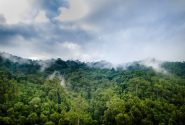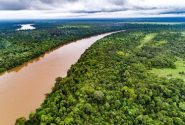
Scientists can create trees with more of the characteristics needed to meet future demands such as resilience to climate change, high-quality wood or more nutritious fruit. Ollivier Girard/CIFOR
YAOUNDE, Cameroon (29 May 2013)_Trees are the oldest and largest beings in the world, living for hundreds, even thousands, of years. But the secret to their longevity – their genetic diversity – is under threat, experts say.
“Trees are highly diverse genetically,” said Laura Snook of Bioversity International during her keynote presentation at CIFOR’s Sustainable forest management in Central Africa conference in Yaoundé. “They contain not only the traits to survive the tests of time, but also the seeds for producing the next generation of trees.”
“But their genetic resources are undergoing an invisible extinction,” she warned.
Snook’s calculations put the total number of trees being removed in the Congo Basin each year, through both formal and informal sectors, at 4 million. Heavy harvesting has left some species very vulnerable, or even endangered, according to the International Union for Conservation of Nature’s Red List.
But looking at the status of species is only part of story, Snook added.
“Species are made of populations that occur in different zones, with different characteristics,” she said.
“So even if a species is not endangered, the status of the populations and their genetic characteristics is more dire.”
Genetic diversity supplies the reserve of characteristics that enables trees and other organisms to adapt over time to changing threats and conditions. It is also used to select individuals for desired traits, such as high quality wood, or sweeter fruit.
“Diversity allows for selection and improvement,” said Snook.
“We can create future trees with more of the characteristics we seek. But most trees have not been selected, leaving a lot of untapped potential.”
Climate change projections for Africa show huge increases in drought and dryness by 2099 – a date that is well within the lifespan of many trees and their seeds, even though most policy makers and researchers will be long gone by then.
“We need to understand the level of tolerance for trees – which species will have the traits to survive climate change,” she said.
“We should be collecting their seeds and exchanging them across borders so they are accessible to the countries that can expect to become increasingly dry in the future.”
The UN Food and Agriculture Organization will soon release the first report on the State of the World’s Forest Genetic Resources. Maintaining seed sources with diverse characteristics is one of its 27 recommendations for action.
“Forests are a renewable resource, and they will continue to produce goods and services as long as they are renewed,” Snook concluded.
“That means replacing trees through good management now to ensure we have the genetic resources to replace them tomorrow.”
For more information on the issues discussed in this article, please contact Manuel Guariguata.
We want you to share Forests News content, which is licensed under Creative Commons Attribution-NonCommercial-ShareAlike 4.0 International (CC BY-NC-SA 4.0). This means you are free to redistribute our material for non-commercial purposes. All we ask is that you give Forests News appropriate credit and link to the original Forests News content, indicate if changes were made, and distribute your contributions under the same Creative Commons license. You must notify Forests News if you repost, reprint or reuse our materials by contacting forestsnews@cifor-icraf.org.










